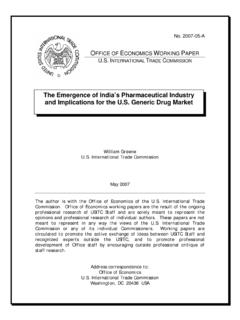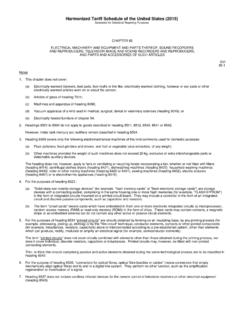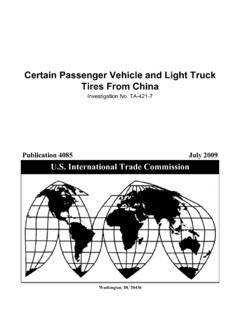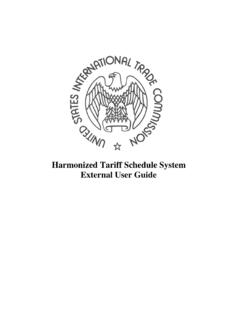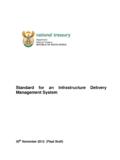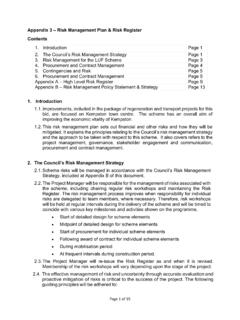Transcription of 332-531 Digital Trade in the U.S. and Gloal Economies, Part 1
1 United States International Trade CommissionInvestigation No. 332-531 USITC Publication 4415 July 2013 Digital Trade in the and Global Economies, Part 1 Address all communications to Secretary to the Commission United States International Trade Commission Washington, DC International Trade CommissionRobert B. KoopmanDirector, Office of OperationsKaren LaneyDirector, Office of IndustriesCOMMISSIONERS Irving A. Williamson, Chairman Daniel R. Pearson Shara L. Aranoff Dean A. Pinkert David S. Johanson Meredith M. International Trade CommissionWashington, DC 20436 2013 USITC Publication 4415 Digital Trade in the and Global Economies, Part 1 Investigation No. 332-531 This report was prepared principally by Project Leader James Stamps Deputy Project Leader Martha Lawless Office of Industries Laura Bloodgood, Sharon Ford, Eric Forden, Jeanette Leary, Katherine Linton, Kathryn Lundquist, George Serletis, Michael Stanton-Geddes, and Isaac Wohl Office of Economics William Greene and David Riker Office of the General Counsel William Gearhart Content Reviewers Michael Ferrantino and Alexander Hammer Office of Analysis and Research Editorial Reviewer Peg Hausman Administrative Support Phyllis Boone and Trina Chambers Help Desk and Customer Service Division Under the direction of Richard Brown, Chief Services Division Office of Industries and Arona Butcher.
2 Chief Country and Regional Analysis Division Office of Economics i Abstract Digital Trade is defined in this report as commerce in products and services delivered via the Internet. This report provides information on the role of Digital Trade in the and global economies, describes notable barriers and impediments to Digital Trade , and outlines potential approaches for further assessing the role of Digital Trade in the economy. Products and services delivered via the Internet make up a growing segment of the economy. Internet technologies have also transformed how many goods and services in the economy are produced and delivered. Digital sales make up more than half of music industry revenue; the Digital shares of sales for games, videos, and books are smaller, but growing quickly.
3 Exports of digitally enabled services (one measure of international Digital Trade ) grew from $ billion in 2007 to $ billion in 2011, with exports exceeding imports every year. Studies that have quantified the economic contributions of the Internet have generally found that it has made significant contributions to output, employment, consumer welfare, Trade , innovation, productivity, and corporate financial performance. Digital Trade can help producers lower their operating costs and work more efficiently. Small and medium-sized enterprises especially benefit from having lower-cost access to a wider range of products, services, and markets. Consumers benefit by gaining greater access to information about products and prices and more convenient ways to shop.
4 Among the most notable barriers and impediments to Digital Trade reported were localization barriers, data privacy and protection measures, intellectual property-related issues, online censorship, as well as impediments to digitally enabled Trade . Editor s note: A technical correction was made to the first sentence of the Royalties and License Fees section on page 4-7 of the report. iii CONTENTS PageAbstract .. iAbbreviations and Acronyms .. ixGlossary .. xiExecutive Summary .. xvChapter 1 Introduction .. 1-1 Objective and approach .. 1-2 Scope .. 1-2 Information sources .. 1-4 Organization of the report .. 1-5 Overview of the evolution of the Internet and its role in facilitating Digital Trade .. 1-7 With significantly expanded access, more people are using the Internet.
5 1-7 Broadband Internet access has become the standard .. 1-9 Wireless broadband is increasingly popular .. 1-12 The number of Internet-connected devices is increasing, creating new channels for Digital Trade .. 1-13 Bibliography .. 1-14 Chapter 2 Digital Trade in the Economy: Digitally Delivered Content, Social Media, Search Engines, and Other Digital Products and Services .. 2-1 Expanding footprints of Digital industries .. 2-2 Digitally delivered content .. 2-5 Economic effects of Digital Trade on content industries .. 2-5 Content delivery and online business models .. 2-9 Growth in online content delivery .. 2-15 Social media.
6 2-21 Social networking sites .. 2-21 User review websites .. 2-25 Search engines .. 2-26 Other Digital products and services and their influence on the economy .. 2-27 Overview of cloud computing services .. 2-27 Software services delivered via the cloud .. 2-29 Data services delivered via the cloud .. 2-31 Communications services delivered via the Internet .. 2-35 Computing platform services delivered via the cloud .. 2-36 Bibliography .. 2-37iv CONTENTS Continued PageChapter 3 Digital Trade in the Economy: Uses of Internet Technologies in the Broader Economy .. 3-1 Digital intensity of industry sectors and the competitive rationales for adopting Internet technologies.
7 3-1 Rankings of Digital intensity of industry sectors .. 3-2 Competitive rationales for adopting Digital technologies in various industry sectors .. 3-5 Digitally enabled services .. 3-7 Retail and e-commerce .. 3-8 Financial services .. 3-14 Professional services .. 3-17 Internet technologies and healthcare .. 3-20 Bibliography .. 3-25 Chapter 4 International Trade and Investment in Digital Trade -related Industries .. 4-1 Data sources 4-1 cross-border services statistics and international Digital Trade .. 4-3 Business, professional, and technical services .. 4-6 Royalties and license fees .. 4-7 Financial and insurance services.
8 4-7 Services data caveats .. 4-8 Foreign investment and Digital Trade .. 4-8 Foreign affiliate sales .. 4-9 Foreign direct investment (FDI) in Digital products and services .. 4-11 Global services Trade data and other measures of international Digital Trade .. 4-20 OECD services Trade data .. 4-20 E-commerce and other measures .. 4-22 Bibliography .. 4-25 Chapter 5 Notable Barriers and Impediments to Digital Trade .. 5-1 Digital Trade localization measures .. 5-2 Companies have had to localize data servers to comply with policies .. 5-4 Certain local-content policies extend to Digital industries .. 5-5 Some government procurement rules favor locally based Digital services or providers.
9 5-7 Data privacy and protection-related measures .. 5-8 Countries take divergent approaches to data privacy and protection .. 5-9 IPR-related measures .. 5-15 Digital content representatives identify piracy as the single most damaging Trade barrier .. 5-15 Internet intermediaries identify unpredictable legal liability as a Digital Trade barrier .. 5-17v CONTENTS Continued PageChapter 5 Notable Barriers and Impediments to Digital Trade Continued Censorship measures .. 5-20 Border measures and immigration limits .. 5-22 Border measures .. 5-22 Immigration limitations.
10 5-23 Affirmative principles that support the free flow of data and information .. 5-25 Bibliography .. 5-28 Chapter 6 Potential Approaches for Assessing the Contributions of Digital Trade to the Economy .. 6-1 Analytical framework for assessing contributions .. 6-1 Literature on quantifying the effects of Digital Trade .. 6-3 The effects on GDP and employment .. 6-3 The effects on consumer welfare .. 6-5 The effects on exports .. 6-6 The effects on business practices .. 6-6 The effects on innovation and productivity .. 6-7 The effects on financial 6-8 Data limitations .. 6-9 Potential approaches to quantifying economic effects .. 6-9 Survey.
